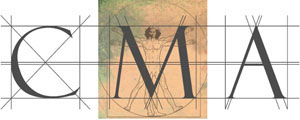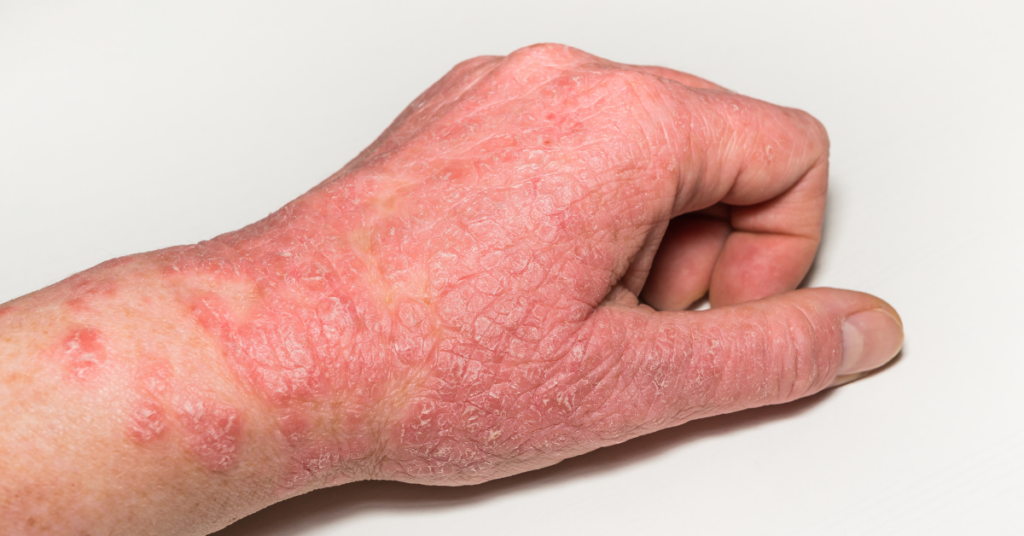What is eczema?
Most commonly seen in young children eczema is a skin condition with the two most common forms being called ‘atopic’ and ‘discoid’. All eczema is a form of dermatitis.
What are the symptoms?
Atopic eczema is red in appearance. The affected skin is very itchy and weepy with tiny spots that cover the skin. A high proportion of children with eczema also have hay fever and asthma. Food allergies are very common amongst people who have eczema.
Discoid eczema usually affects young adults and is characterised by coin shaped patches on the skin that become itchy and blistered.
Because so many skin disorders look similar it is vital you have the skin condition diagnosed before taking treatment for it. The dosages listed below are for adults not children. For children’s dosages, please consult a qualified practitioner.
What causes eczema / dermatitis?
The main causes of eczema are allergies to food or the environment, although some causes can be hereditary.
Complementary Approach
Diet: Drink at least eight glasses of good quality water a day, eat a healthy well-balanced diet with lots of fruit and vegetables; include brown rice and millet in your diet.
Avoid Eating: Sugar, inflammatory foods such as trans fats, Ultra Processed Foods (UPFs). Research shows that those who stopped drinking coffee found their condition improved.1
The studies show that it was a reaction to the coffee but not to caffeine that triggered outbreaks. Avoid all junk foods, all dairy products, sugar, fats, fried foods and white flour products. Practitioners recommend that you try a gluten-free diet for six weeks to ascertain whether this might be a factor in your eczema. After six weeks reintroduce gluten-containing foods; if you are sensitive to gluten your skin condition will worsen with the reintroduction of these foods.
A vitamin called biotin is needed for scalp and skin disorders, but this vitamin cannot be absorbed by the body if a protein called avidin is in the system so avoid foods that contain avidin (raw eggs).
Eczema can be triggered by allergies,2,3 and a visit to a qualified nutritionist is advised. If allergies are the cause of eczema, by removing the allergen, great improvements are sure to be seen.4 Research shows that most children with eczema are allergic to certain foods.5
The following information does not constitute a prescription or recommended dose – studies have been conducted using the dosages stated and are included for your information only.
The nutrients mentioned here are often recommended by Health Care practitioners.
Nutritional Supplements
Evening primrose oil contains GLA’s (gamma-linolenic acid) so too does borage and blackcurrant seed oil. Now researchers have found that people with eczema are unable to process fatty acids effectively and thus become deficient in GLA.6 By taking evening primrose oil, those with eczema reported that they were less itchy, suggesting that evening primrose oil overcomes this block and is beneficial for those who have eczema.10,9,8
In the trials, 12 pills a day were administered; each pill contained 500 mg of evening primrose oil, of which 45 mg was GLA.
Vitamin B complex For optimal circulation and healthy skin. Take 50-100 mg 3 times daily with meals. Use non-dairy form.
Vitamin B3 Also for optimal circulation and healthy skin. Take 100 mg 3 times daily, do not exceed dose.
Vitamin B6 Skin disorders have been linked to deficiency. Take 50 mg 3 times daily.
Vitamin B12 helps with cell formation. Take 200 mcg daily.
Biotin Skin disorders have been linked to deficiency. Take 300 mg daily.
Herbs
Licorice can be used either internally or topically and is a very popular treatment for eczema with Chinese herbalists. Trials support its use in childhood and adult eczema.11,12
Licorice root has in it an acid called glycyrrhetinic acid and this constituent of liquorice root reduces the inflammation and itching associated with eczema.13
Apply creams or ointments that contain glycyrrhetinic acid to the affected area 3-4 times a day.
Witch hazel People with eczema are usually prescribed creams containing 1% hydrocortisone, yet creams containing witch hazel and phosphatidyl choline have been reported to be just as effective.14
Burdock supports healthy liver function, which is why it has been used historically in the treatment of skin conditions. It works on the theory that the liver can help cleanse the body of skin-damaging compounds.
Calendula and chamomile have anti-inflammatory properties and are often used in traditional herbal medicine, as too, is Chickweed as it reduces itching. Look for creams or ointments that contain these herbs. Wild oats and red clover have also been traditionally used to bring about relief.
Sarsaparilla has anti-inflammatory properties and for this reason is used to treat skin conditions. Take 9 grams of dried root daily in divided doses or take in tincture form in 3 ml doses 3 times a day.
Oak If your eczema is weeping and oozing try using oak. It is thought that the tannins found in oak absorb toxins and soothe inflamed tissues. Topical application containing this compound has been used with great success in clinical practice.15
How to make: Boil 500 ml of water in a pan to which you need to add 15-30 grams of the oak bark. Boil for 15 minutes, and when cool dip a cloth into the liquid and apply directly onto the affected area, several times a day. The liquid should only be kept for one day, making a new batch the following morning.
Further Information
As with all skin conditions, it is vital that you keep the colon clean by ensuring that you east sufficient levels of fibre. Taking supplements such as psyllium husks or flaxseed are a useful adjunct. Take as directed on the label.
References
- Veien NK, Hattel T, Justesen O, et al. Dermatoses in coffee drinkers. Cutis 1987;40:421–22.
- Sampson HA, Scanlon SM. Natural history of food hypersensitivity in children with atopic dermatitis. J Pediatr 1989;115:23–27.
- Burks AW, Mallory SB, Williams LW, Shirrell MA. Atopic dermatitis: Clinical relevance of food hypersensitivity. J Pediatr 1988;113:447–51.
- Atherton DJ. Diet and atopic eczema. Clin Allerg 1988;18:215–28 [review].
- Niggemann B, Sielaff B, Beyer K, et al. Outcome of double-blind, placebo-controlled food challenge tests in 107 children with atopic dermatitis. Clin Exp Allergy 1999;29:91–96.
- Manku MS, Horrobin DF, Morse NL, et al. Essential fatty acids in the plasma phospholipids of patients with atopic eczema. Br J Dermatol 1984;110:643–48.
- Morse PF, Horrobin DF, Manku MS, et al. Meta-analysis of placebo-controlled studies of the efficacy of Epogam in the treatment of atopic eczema. Relationship between plasma essential fatty acid changes and clinical response. Br J Dermatol 1989;121:75–90.
- Schalin-Karrila M, Mattila L, Jansen CT, et al. Evening primrose oil in the treatment of atopic eczema: effect on clinical status, plasma phospholipid fatty acids and circulating blood prostaglandins. Br J Dermatol 1987;117:11–19.
- Lovell CR, Burton JL, Horrobin DF. Treatment of atopic eczema with evening primrose oil. Lancet1981;I:278 [letter].
- Wright S, Burton JL. Oral evening-primrose oil improves atopic eczema. Lancet 1982;ii:1120–22.
- Sheehan MP, Atherton DJ. One-year follow up of children treated with Chinese medical herbs for atopic eczema. Br J Dermatol 1994;130:488–93.
- Sheehan MP, Rustin MHA, et al. Efficacy of traditional Chinese herbal therapy in adult atopic dermatitis. Lancet 1992;340:13–17.
- Evans FQ. The rational use of glycyrrhetinic acid in dermatology. Br J Clin Pract 1958;12: 269–79.
- Laux P, Oschmann R. Witch hazel – Hamamelis virgincia L. Zeitschrift Phytother 1993;14: 155–66.
- Weiss RF. Herbal Medicine. Gothenberg, Sweden: Ab Arcanum and Beaconsfield: Beaconsfield Publishers Ltd, 1988, 328–29.

